Requirements Report: Telehealth System Analysis and SDLC Approach
VerifiedAdded on 2023/04/25
|10
|2766
|188
Report
AI Summary
This report provides a comprehensive analysis of the requirements for a Telehealth system, focusing on non-functional requirements such as availability, reliability, confidentiality, usability, performance, scalability, maintainability, accessibility, and security. It explores the benefits and weaknesses of cloud-based solutions for Telehealth, highlighting advantages like easy access and flexibility, as well as disadvantages such as downtime and security concerns. The report also examines the Software Development Life Cycle (SDLC) approach, discussing its phases, models, advantages, and disadvantages, and recommending its use for smaller projects. The report concludes that Telehealth would benefit from adopting a cloud solution due to its high storage capacity and ability to ensure proper data storage, making data accessible at any time.

Running head: REQUIREMENTS REPORT
REQUIREMENTS REPORT OF TELEHEALTH
Name of the student
Name of the University
Author Note
REQUIREMENTS REPORT OF TELEHEALTH
Name of the student
Name of the University
Author Note
Paraphrase This Document
Need a fresh take? Get an instant paraphrase of this document with our AI Paraphraser
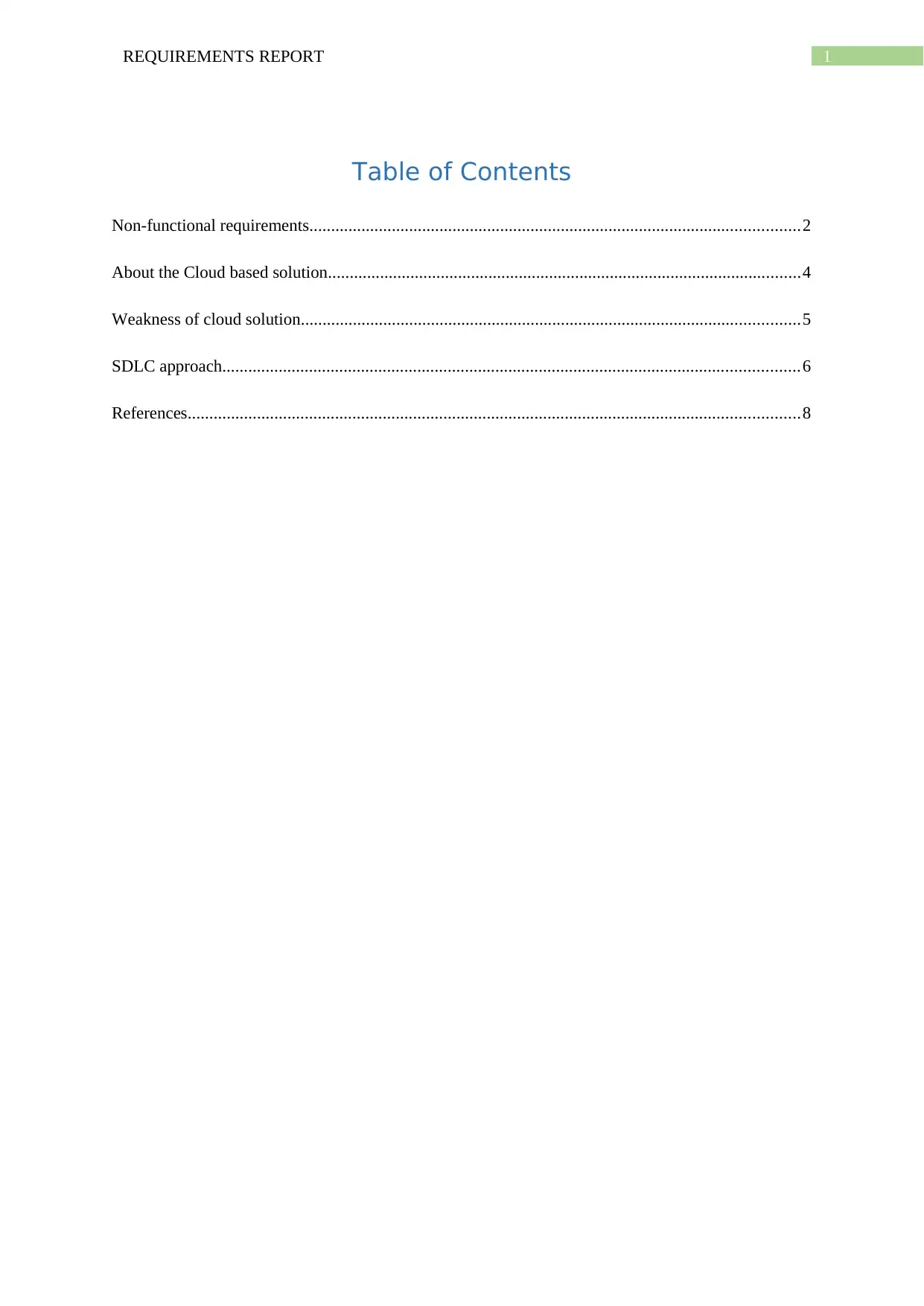
1REQUIREMENTS REPORT
Table of Contents
Non-functional requirements.................................................................................................................2
About the Cloud based solution.............................................................................................................4
Weakness of cloud solution...................................................................................................................5
SDLC approach.....................................................................................................................................6
References.............................................................................................................................................8
Table of Contents
Non-functional requirements.................................................................................................................2
About the Cloud based solution.............................................................................................................4
Weakness of cloud solution...................................................................................................................5
SDLC approach.....................................................................................................................................6
References.............................................................................................................................................8
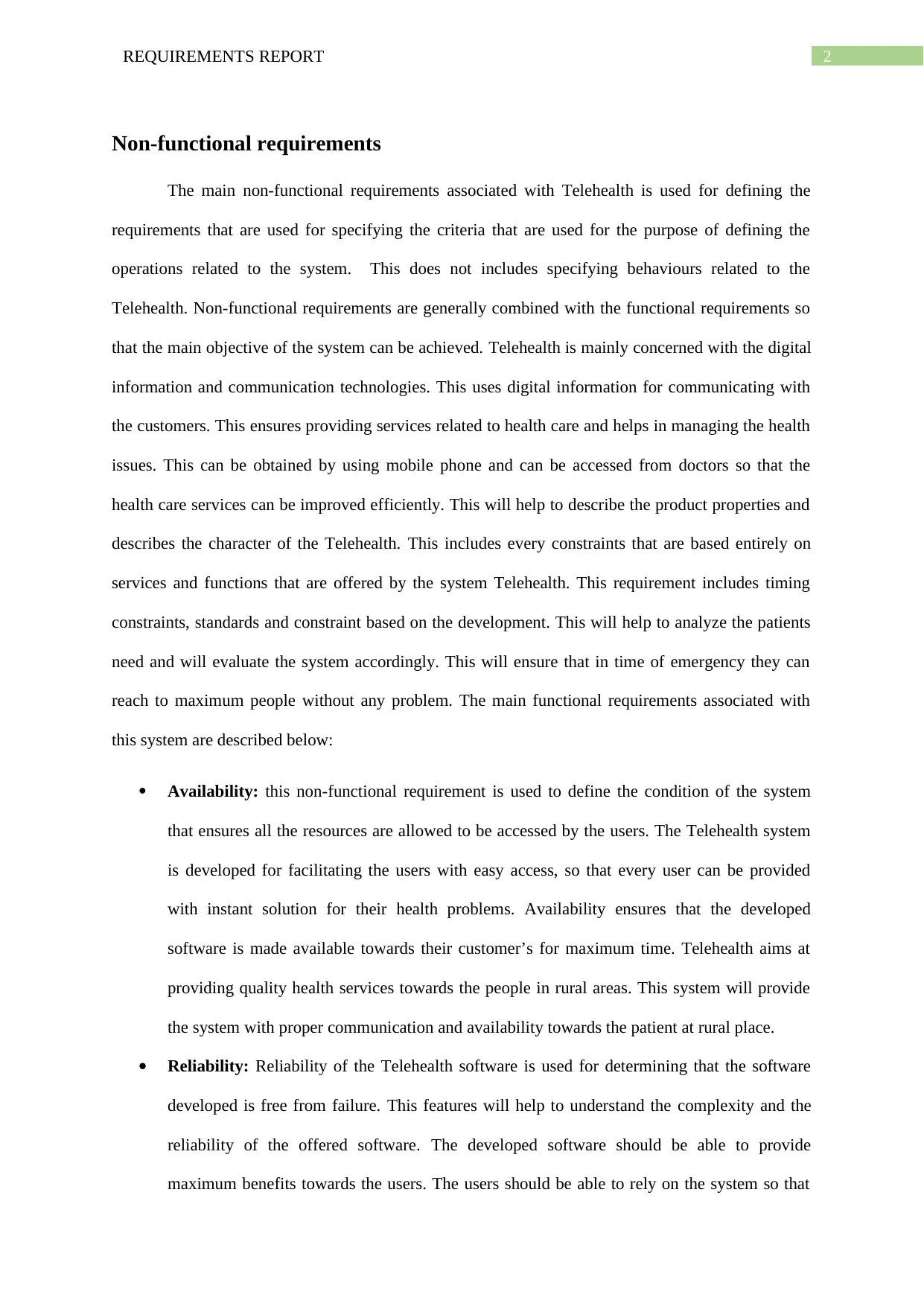
2REQUIREMENTS REPORT
Non-functional requirements
The main non-functional requirements associated with Telehealth is used for defining the
requirements that are used for specifying the criteria that are used for the purpose of defining the
operations related to the system. This does not includes specifying behaviours related to the
Telehealth. Non-functional requirements are generally combined with the functional requirements so
that the main objective of the system can be achieved. Telehealth is mainly concerned with the digital
information and communication technologies. This uses digital information for communicating with
the customers. This ensures providing services related to health care and helps in managing the health
issues. This can be obtained by using mobile phone and can be accessed from doctors so that the
health care services can be improved efficiently. This will help to describe the product properties and
describes the character of the Telehealth. This includes every constraints that are based entirely on
services and functions that are offered by the system Telehealth. This requirement includes timing
constraints, standards and constraint based on the development. This will help to analyze the patients
need and will evaluate the system accordingly. This will ensure that in time of emergency they can
reach to maximum people without any problem. The main functional requirements associated with
this system are described below:
Availability: this non-functional requirement is used to define the condition of the system
that ensures all the resources are allowed to be accessed by the users. The Telehealth system
is developed for facilitating the users with easy access, so that every user can be provided
with instant solution for their health problems. Availability ensures that the developed
software is made available towards their customer’s for maximum time. Telehealth aims at
providing quality health services towards the people in rural areas. This system will provide
the system with proper communication and availability towards the patient at rural place.
Reliability: Reliability of the Telehealth software is used for determining that the software
developed is free from failure. This features will help to understand the complexity and the
reliability of the offered software. The developed software should be able to provide
maximum benefits towards the users. The users should be able to rely on the system so that
Non-functional requirements
The main non-functional requirements associated with Telehealth is used for defining the
requirements that are used for specifying the criteria that are used for the purpose of defining the
operations related to the system. This does not includes specifying behaviours related to the
Telehealth. Non-functional requirements are generally combined with the functional requirements so
that the main objective of the system can be achieved. Telehealth is mainly concerned with the digital
information and communication technologies. This uses digital information for communicating with
the customers. This ensures providing services related to health care and helps in managing the health
issues. This can be obtained by using mobile phone and can be accessed from doctors so that the
health care services can be improved efficiently. This will help to describe the product properties and
describes the character of the Telehealth. This includes every constraints that are based entirely on
services and functions that are offered by the system Telehealth. This requirement includes timing
constraints, standards and constraint based on the development. This will help to analyze the patients
need and will evaluate the system accordingly. This will ensure that in time of emergency they can
reach to maximum people without any problem. The main functional requirements associated with
this system are described below:
Availability: this non-functional requirement is used to define the condition of the system
that ensures all the resources are allowed to be accessed by the users. The Telehealth system
is developed for facilitating the users with easy access, so that every user can be provided
with instant solution for their health problems. Availability ensures that the developed
software is made available towards their customer’s for maximum time. Telehealth aims at
providing quality health services towards the people in rural areas. This system will provide
the system with proper communication and availability towards the patient at rural place.
Reliability: Reliability of the Telehealth software is used for determining that the software
developed is free from failure. This features will help to understand the complexity and the
reliability of the offered software. The developed software should be able to provide
maximum benefits towards the users. The users should be able to rely on the system so that
⊘ This is a preview!⊘
Do you want full access?
Subscribe today to unlock all pages.

Trusted by 1+ million students worldwide
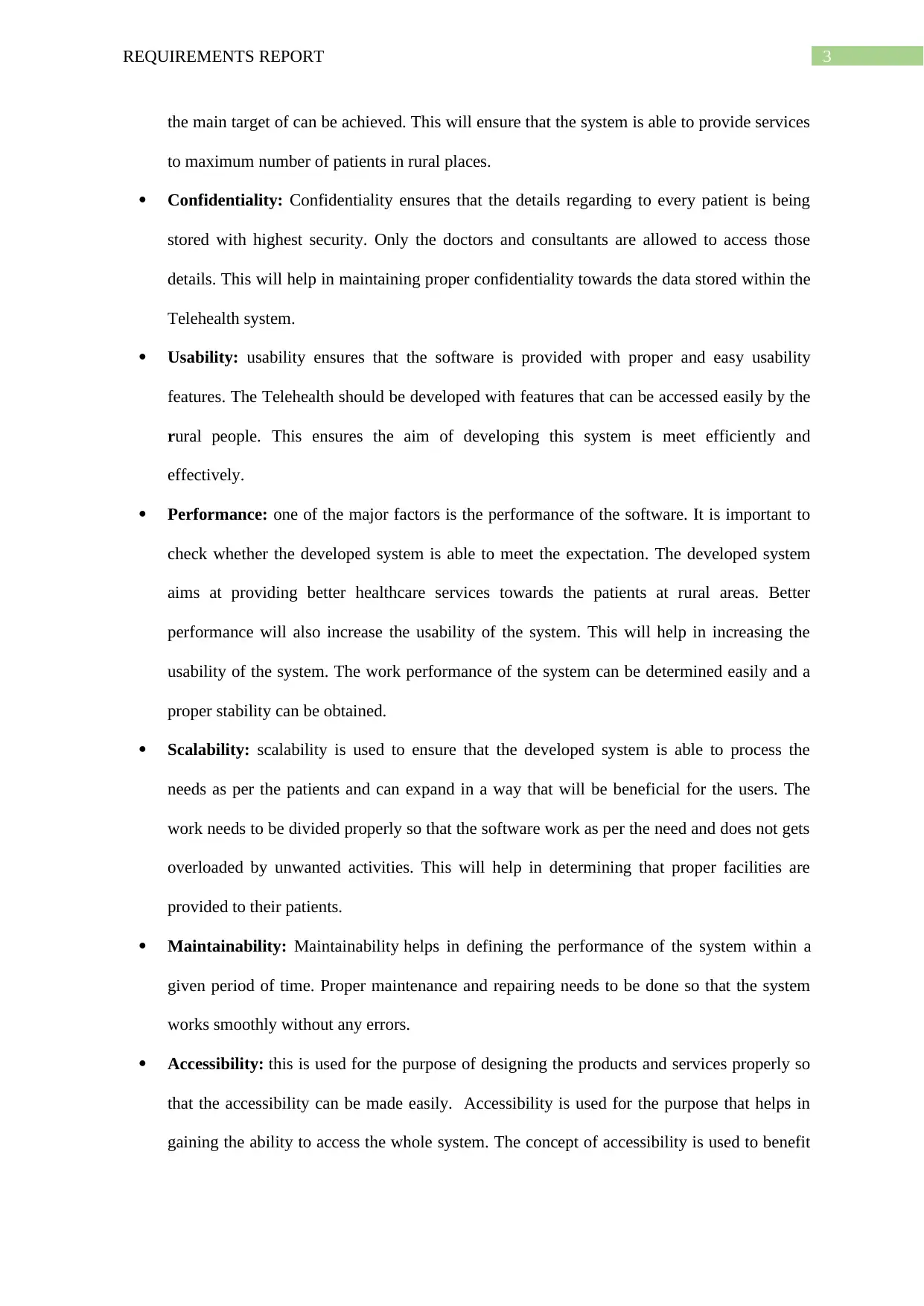
3REQUIREMENTS REPORT
the main target of can be achieved. This will ensure that the system is able to provide services
to maximum number of patients in rural places.
Confidentiality: Confidentiality ensures that the details regarding to every patient is being
stored with highest security. Only the doctors and consultants are allowed to access those
details. This will help in maintaining proper confidentiality towards the data stored within the
Telehealth system.
Usability: usability ensures that the software is provided with proper and easy usability
features. The Telehealth should be developed with features that can be accessed easily by the
rural people. This ensures the aim of developing this system is meet efficiently and
effectively.
Performance: one of the major factors is the performance of the software. It is important to
check whether the developed system is able to meet the expectation. The developed system
aims at providing better healthcare services towards the patients at rural areas. Better
performance will also increase the usability of the system. This will help in increasing the
usability of the system. The work performance of the system can be determined easily and a
proper stability can be obtained.
Scalability: scalability is used to ensure that the developed system is able to process the
needs as per the patients and can expand in a way that will be beneficial for the users. The
work needs to be divided properly so that the software work as per the need and does not gets
overloaded by unwanted activities. This will help in determining that proper facilities are
provided to their patients.
Maintainability: Maintainability helps in defining the performance of the system within a
given period of time. Proper maintenance and repairing needs to be done so that the system
works smoothly without any errors.
Accessibility: this is used for the purpose of designing the products and services properly so
that the accessibility can be made easily. Accessibility is used for the purpose that helps in
gaining the ability to access the whole system. The concept of accessibility is used to benefit
the main target of can be achieved. This will ensure that the system is able to provide services
to maximum number of patients in rural places.
Confidentiality: Confidentiality ensures that the details regarding to every patient is being
stored with highest security. Only the doctors and consultants are allowed to access those
details. This will help in maintaining proper confidentiality towards the data stored within the
Telehealth system.
Usability: usability ensures that the software is provided with proper and easy usability
features. The Telehealth should be developed with features that can be accessed easily by the
rural people. This ensures the aim of developing this system is meet efficiently and
effectively.
Performance: one of the major factors is the performance of the software. It is important to
check whether the developed system is able to meet the expectation. The developed system
aims at providing better healthcare services towards the patients at rural areas. Better
performance will also increase the usability of the system. This will help in increasing the
usability of the system. The work performance of the system can be determined easily and a
proper stability can be obtained.
Scalability: scalability is used to ensure that the developed system is able to process the
needs as per the patients and can expand in a way that will be beneficial for the users. The
work needs to be divided properly so that the software work as per the need and does not gets
overloaded by unwanted activities. This will help in determining that proper facilities are
provided to their patients.
Maintainability: Maintainability helps in defining the performance of the system within a
given period of time. Proper maintenance and repairing needs to be done so that the system
works smoothly without any errors.
Accessibility: this is used for the purpose of designing the products and services properly so
that the accessibility can be made easily. Accessibility is used for the purpose that helps in
gaining the ability to access the whole system. The concept of accessibility is used to benefit
Paraphrase This Document
Need a fresh take? Get an instant paraphrase of this document with our AI Paraphraser
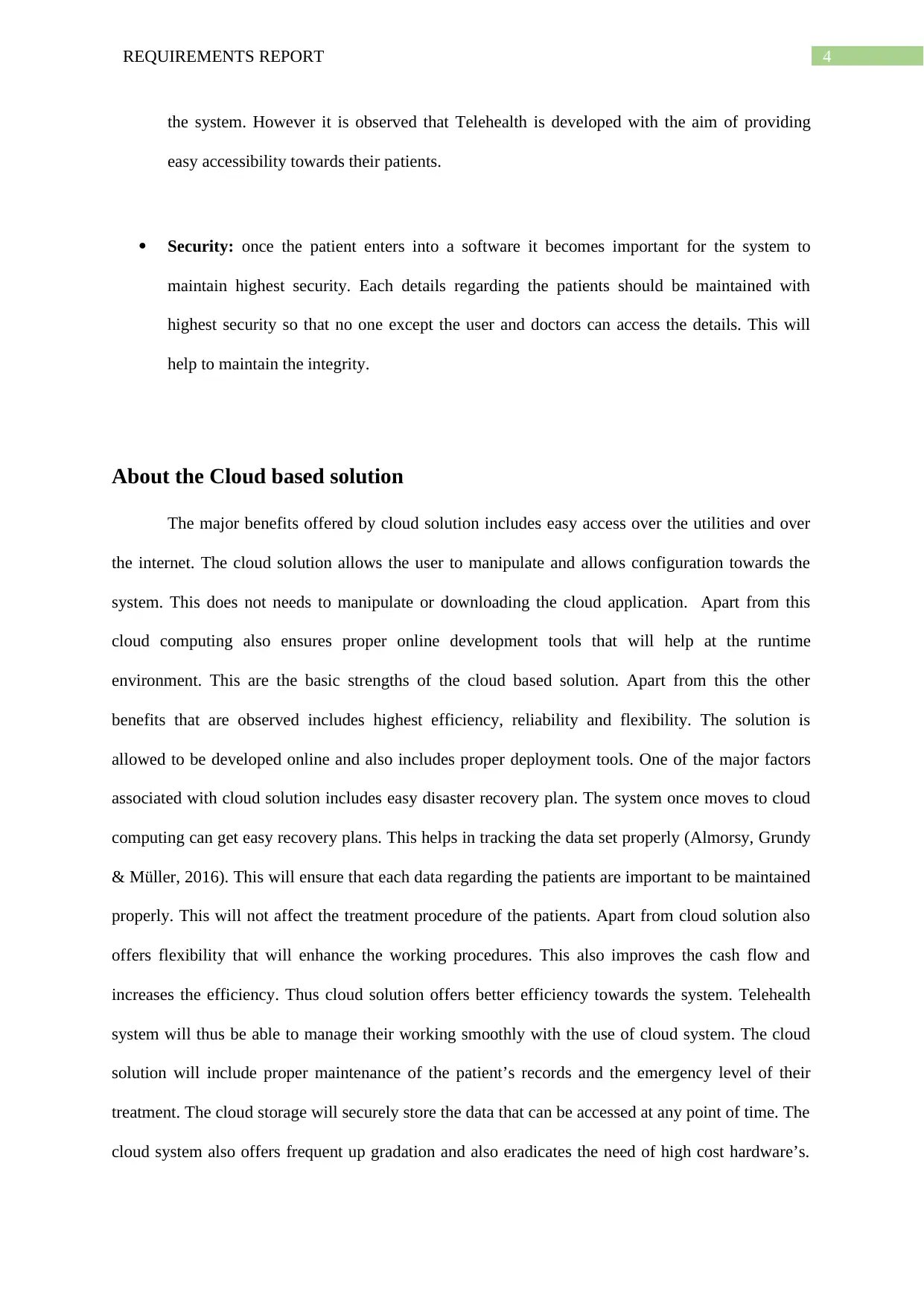
4REQUIREMENTS REPORT
the system. However it is observed that Telehealth is developed with the aim of providing
easy accessibility towards their patients.
Security: once the patient enters into a software it becomes important for the system to
maintain highest security. Each details regarding the patients should be maintained with
highest security so that no one except the user and doctors can access the details. This will
help to maintain the integrity.
About the Cloud based solution
The major benefits offered by cloud solution includes easy access over the utilities and over
the internet. The cloud solution allows the user to manipulate and allows configuration towards the
system. This does not needs to manipulate or downloading the cloud application. Apart from this
cloud computing also ensures proper online development tools that will help at the runtime
environment. This are the basic strengths of the cloud based solution. Apart from this the other
benefits that are observed includes highest efficiency, reliability and flexibility. The solution is
allowed to be developed online and also includes proper deployment tools. One of the major factors
associated with cloud solution includes easy disaster recovery plan. The system once moves to cloud
computing can get easy recovery plans. This helps in tracking the data set properly (Almorsy, Grundy
& Müller, 2016). This will ensure that each data regarding the patients are important to be maintained
properly. This will not affect the treatment procedure of the patients. Apart from cloud solution also
offers flexibility that will enhance the working procedures. This also improves the cash flow and
increases the efficiency. Thus cloud solution offers better efficiency towards the system. Telehealth
system will thus be able to manage their working smoothly with the use of cloud system. The cloud
solution will include proper maintenance of the patient’s records and the emergency level of their
treatment. The cloud storage will securely store the data that can be accessed at any point of time. The
cloud system also offers frequent up gradation and also eradicates the need of high cost hardware’s.
the system. However it is observed that Telehealth is developed with the aim of providing
easy accessibility towards their patients.
Security: once the patient enters into a software it becomes important for the system to
maintain highest security. Each details regarding the patients should be maintained with
highest security so that no one except the user and doctors can access the details. This will
help to maintain the integrity.
About the Cloud based solution
The major benefits offered by cloud solution includes easy access over the utilities and over
the internet. The cloud solution allows the user to manipulate and allows configuration towards the
system. This does not needs to manipulate or downloading the cloud application. Apart from this
cloud computing also ensures proper online development tools that will help at the runtime
environment. This are the basic strengths of the cloud based solution. Apart from this the other
benefits that are observed includes highest efficiency, reliability and flexibility. The solution is
allowed to be developed online and also includes proper deployment tools. One of the major factors
associated with cloud solution includes easy disaster recovery plan. The system once moves to cloud
computing can get easy recovery plans. This helps in tracking the data set properly (Almorsy, Grundy
& Müller, 2016). This will ensure that each data regarding the patients are important to be maintained
properly. This will not affect the treatment procedure of the patients. Apart from cloud solution also
offers flexibility that will enhance the working procedures. This also improves the cash flow and
increases the efficiency. Thus cloud solution offers better efficiency towards the system. Telehealth
system will thus be able to manage their working smoothly with the use of cloud system. The cloud
solution will include proper maintenance of the patient’s records and the emergency level of their
treatment. The cloud storage will securely store the data that can be accessed at any point of time. The
cloud system also offers frequent up gradation and also eradicates the need of high cost hardware’s.
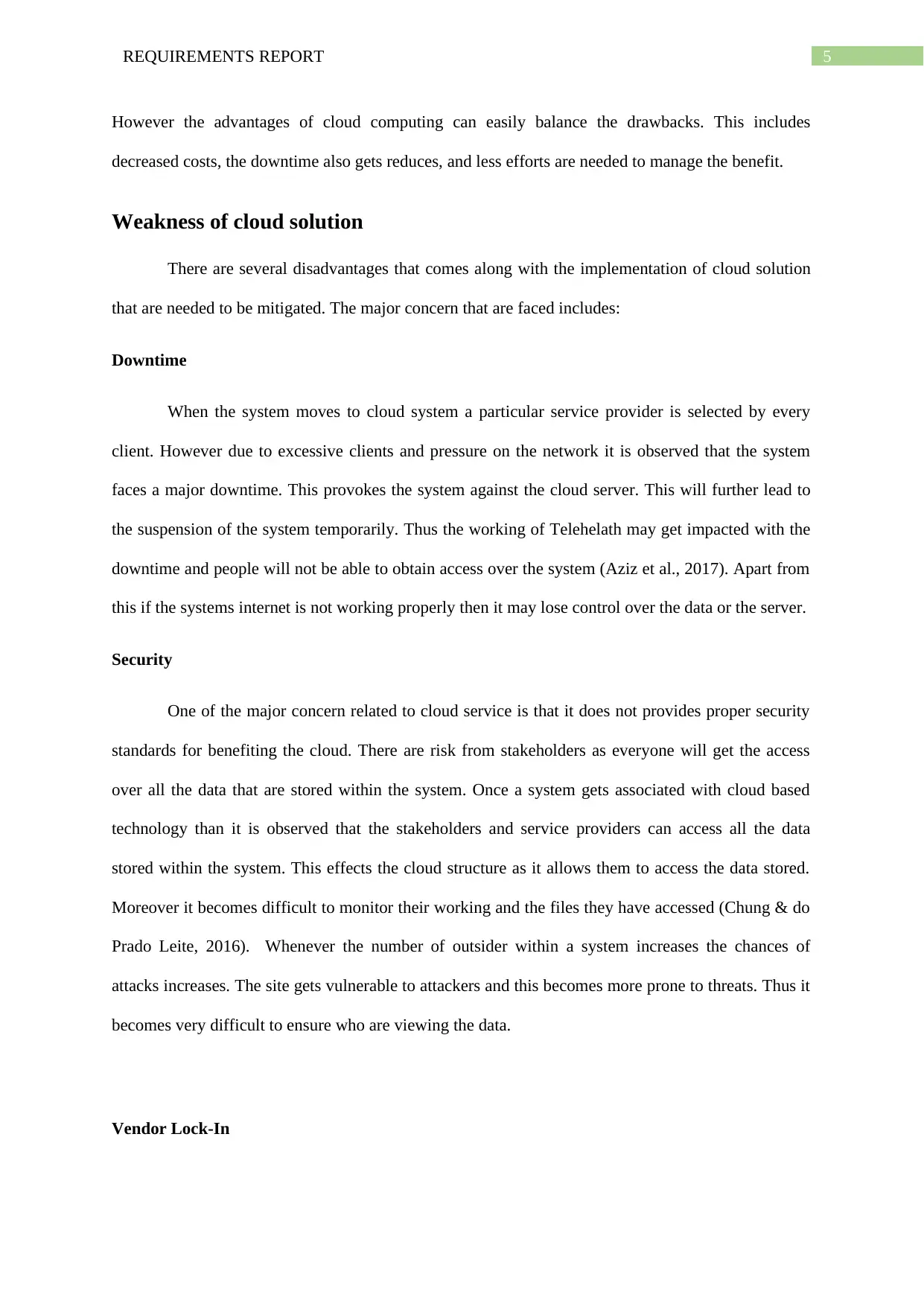
5REQUIREMENTS REPORT
However the advantages of cloud computing can easily balance the drawbacks. This includes
decreased costs, the downtime also gets reduces, and less efforts are needed to manage the benefit.
Weakness of cloud solution
There are several disadvantages that comes along with the implementation of cloud solution
that are needed to be mitigated. The major concern that are faced includes:
Downtime
When the system moves to cloud system a particular service provider is selected by every
client. However due to excessive clients and pressure on the network it is observed that the system
faces a major downtime. This provokes the system against the cloud server. This will further lead to
the suspension of the system temporarily. Thus the working of Telehelath may get impacted with the
downtime and people will not be able to obtain access over the system (Aziz et al., 2017). Apart from
this if the systems internet is not working properly then it may lose control over the data or the server.
Security
One of the major concern related to cloud service is that it does not provides proper security
standards for benefiting the cloud. There are risk from stakeholders as everyone will get the access
over all the data that are stored within the system. Once a system gets associated with cloud based
technology than it is observed that the stakeholders and service providers can access all the data
stored within the system. This effects the cloud structure as it allows them to access the data stored.
Moreover it becomes difficult to monitor their working and the files they have accessed (Chung & do
Prado Leite, 2016). Whenever the number of outsider within a system increases the chances of
attacks increases. The site gets vulnerable to attackers and this becomes more prone to threats. Thus it
becomes very difficult to ensure who are viewing the data.
Vendor Lock-In
However the advantages of cloud computing can easily balance the drawbacks. This includes
decreased costs, the downtime also gets reduces, and less efforts are needed to manage the benefit.
Weakness of cloud solution
There are several disadvantages that comes along with the implementation of cloud solution
that are needed to be mitigated. The major concern that are faced includes:
Downtime
When the system moves to cloud system a particular service provider is selected by every
client. However due to excessive clients and pressure on the network it is observed that the system
faces a major downtime. This provokes the system against the cloud server. This will further lead to
the suspension of the system temporarily. Thus the working of Telehelath may get impacted with the
downtime and people will not be able to obtain access over the system (Aziz et al., 2017). Apart from
this if the systems internet is not working properly then it may lose control over the data or the server.
Security
One of the major concern related to cloud service is that it does not provides proper security
standards for benefiting the cloud. There are risk from stakeholders as everyone will get the access
over all the data that are stored within the system. Once a system gets associated with cloud based
technology than it is observed that the stakeholders and service providers can access all the data
stored within the system. This effects the cloud structure as it allows them to access the data stored.
Moreover it becomes difficult to monitor their working and the files they have accessed (Chung & do
Prado Leite, 2016). Whenever the number of outsider within a system increases the chances of
attacks increases. The site gets vulnerable to attackers and this becomes more prone to threats. Thus it
becomes very difficult to ensure who are viewing the data.
Vendor Lock-In
⊘ This is a preview!⊘
Do you want full access?
Subscribe today to unlock all pages.

Trusted by 1+ million students worldwide
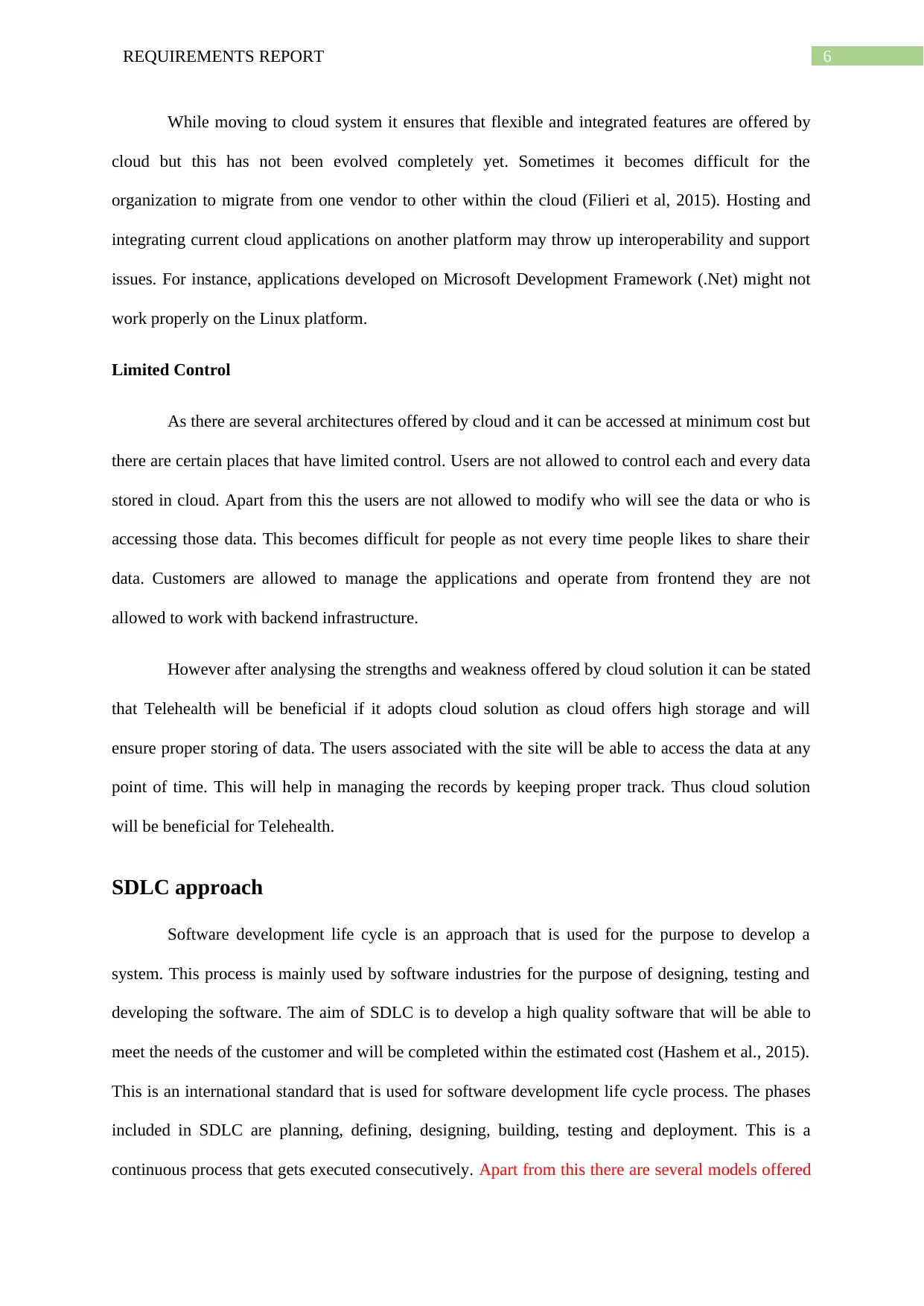
6REQUIREMENTS REPORT
While moving to cloud system it ensures that flexible and integrated features are offered by
cloud but this has not been evolved completely yet. Sometimes it becomes difficult for the
organization to migrate from one vendor to other within the cloud (Filieri et al, 2015). Hosting and
integrating current cloud applications on another platform may throw up interoperability and support
issues. For instance, applications developed on Microsoft Development Framework (.Net) might not
work properly on the Linux platform.
Limited Control
As there are several architectures offered by cloud and it can be accessed at minimum cost but
there are certain places that have limited control. Users are not allowed to control each and every data
stored in cloud. Apart from this the users are not allowed to modify who will see the data or who is
accessing those data. This becomes difficult for people as not every time people likes to share their
data. Customers are allowed to manage the applications and operate from frontend they are not
allowed to work with backend infrastructure.
However after analysing the strengths and weakness offered by cloud solution it can be stated
that Telehealth will be beneficial if it adopts cloud solution as cloud offers high storage and will
ensure proper storing of data. The users associated with the site will be able to access the data at any
point of time. This will help in managing the records by keeping proper track. Thus cloud solution
will be beneficial for Telehealth.
SDLC approach
Software development life cycle is an approach that is used for the purpose to develop a
system. This process is mainly used by software industries for the purpose of designing, testing and
developing the software. The aim of SDLC is to develop a high quality software that will be able to
meet the needs of the customer and will be completed within the estimated cost (Hashem et al., 2015).
This is an international standard that is used for software development life cycle process. The phases
included in SDLC are planning, defining, designing, building, testing and deployment. This is a
continuous process that gets executed consecutively. Apart from this there are several models offered
While moving to cloud system it ensures that flexible and integrated features are offered by
cloud but this has not been evolved completely yet. Sometimes it becomes difficult for the
organization to migrate from one vendor to other within the cloud (Filieri et al, 2015). Hosting and
integrating current cloud applications on another platform may throw up interoperability and support
issues. For instance, applications developed on Microsoft Development Framework (.Net) might not
work properly on the Linux platform.
Limited Control
As there are several architectures offered by cloud and it can be accessed at minimum cost but
there are certain places that have limited control. Users are not allowed to control each and every data
stored in cloud. Apart from this the users are not allowed to modify who will see the data or who is
accessing those data. This becomes difficult for people as not every time people likes to share their
data. Customers are allowed to manage the applications and operate from frontend they are not
allowed to work with backend infrastructure.
However after analysing the strengths and weakness offered by cloud solution it can be stated
that Telehealth will be beneficial if it adopts cloud solution as cloud offers high storage and will
ensure proper storing of data. The users associated with the site will be able to access the data at any
point of time. This will help in managing the records by keeping proper track. Thus cloud solution
will be beneficial for Telehealth.
SDLC approach
Software development life cycle is an approach that is used for the purpose to develop a
system. This process is mainly used by software industries for the purpose of designing, testing and
developing the software. The aim of SDLC is to develop a high quality software that will be able to
meet the needs of the customer and will be completed within the estimated cost (Hashem et al., 2015).
This is an international standard that is used for software development life cycle process. The phases
included in SDLC are planning, defining, designing, building, testing and deployment. This is a
continuous process that gets executed consecutively. Apart from this there are several models offered
Paraphrase This Document
Need a fresh take? Get an instant paraphrase of this document with our AI Paraphraser

7REQUIREMENTS REPORT
by SDLC that includes waterfall model, iterative model, spiral model, and V model. The main
advantages offered by SDLC includes: easy to develop and proper maintenance can be provided, the
system is predictable to some extent, the cycle gets repeated based on the need. Apart from this SDLC
also offers short iteration procedures hence it becomes easier to test the debugging stages and also
ensures that the risks associated with different stages can be controlled properly without any lack.
however apart from this advantages the major drawbacks of SDLC are they provide long feedback
loops, this are not very adaptive in nature, the developed system is poor in quality. However it is
recommended that for small project SDLC approach should not be used as this process becomes
difficult to manage at the smaller level.
The two approaches that are offered by SDLC are adaptive software development lifecycle
and predictive software development lifecycle.
Adaptive software development was evolved mainly from the RAD practices. This occurs in a
circular evolutionary model with the phases that helps in understanding the complexity of the system.
The different phases associated with the development life cycle includes speculate, collaborate and
learn. These three phases are generally used for the purpose of reflecting the dynamic nature of
adaptive software. The reason behind adapting this software development life cycle is that it has six
basic characteristics that are as follows mission based, feature based, iterative, time boxed, risk driven
and change tolerant. Whereas the predictive SDLC approach helps in assuming that the development
phase is planned based on the advance and new information system. However adaptive approach is
used when the exact requirements are not clear for the developer. However it can be stated that the
predictive software development model is used when the objectives are clear for the organisation.
Thus it is recommended that predictive SDLCC approach will be helpful for Telehealth organization.
by SDLC that includes waterfall model, iterative model, spiral model, and V model. The main
advantages offered by SDLC includes: easy to develop and proper maintenance can be provided, the
system is predictable to some extent, the cycle gets repeated based on the need. Apart from this SDLC
also offers short iteration procedures hence it becomes easier to test the debugging stages and also
ensures that the risks associated with different stages can be controlled properly without any lack.
however apart from this advantages the major drawbacks of SDLC are they provide long feedback
loops, this are not very adaptive in nature, the developed system is poor in quality. However it is
recommended that for small project SDLC approach should not be used as this process becomes
difficult to manage at the smaller level.
The two approaches that are offered by SDLC are adaptive software development lifecycle
and predictive software development lifecycle.
Adaptive software development was evolved mainly from the RAD practices. This occurs in a
circular evolutionary model with the phases that helps in understanding the complexity of the system.
The different phases associated with the development life cycle includes speculate, collaborate and
learn. These three phases are generally used for the purpose of reflecting the dynamic nature of
adaptive software. The reason behind adapting this software development life cycle is that it has six
basic characteristics that are as follows mission based, feature based, iterative, time boxed, risk driven
and change tolerant. Whereas the predictive SDLC approach helps in assuming that the development
phase is planned based on the advance and new information system. However adaptive approach is
used when the exact requirements are not clear for the developer. However it can be stated that the
predictive software development model is used when the objectives are clear for the organisation.
Thus it is recommended that predictive SDLCC approach will be helpful for Telehealth organization.
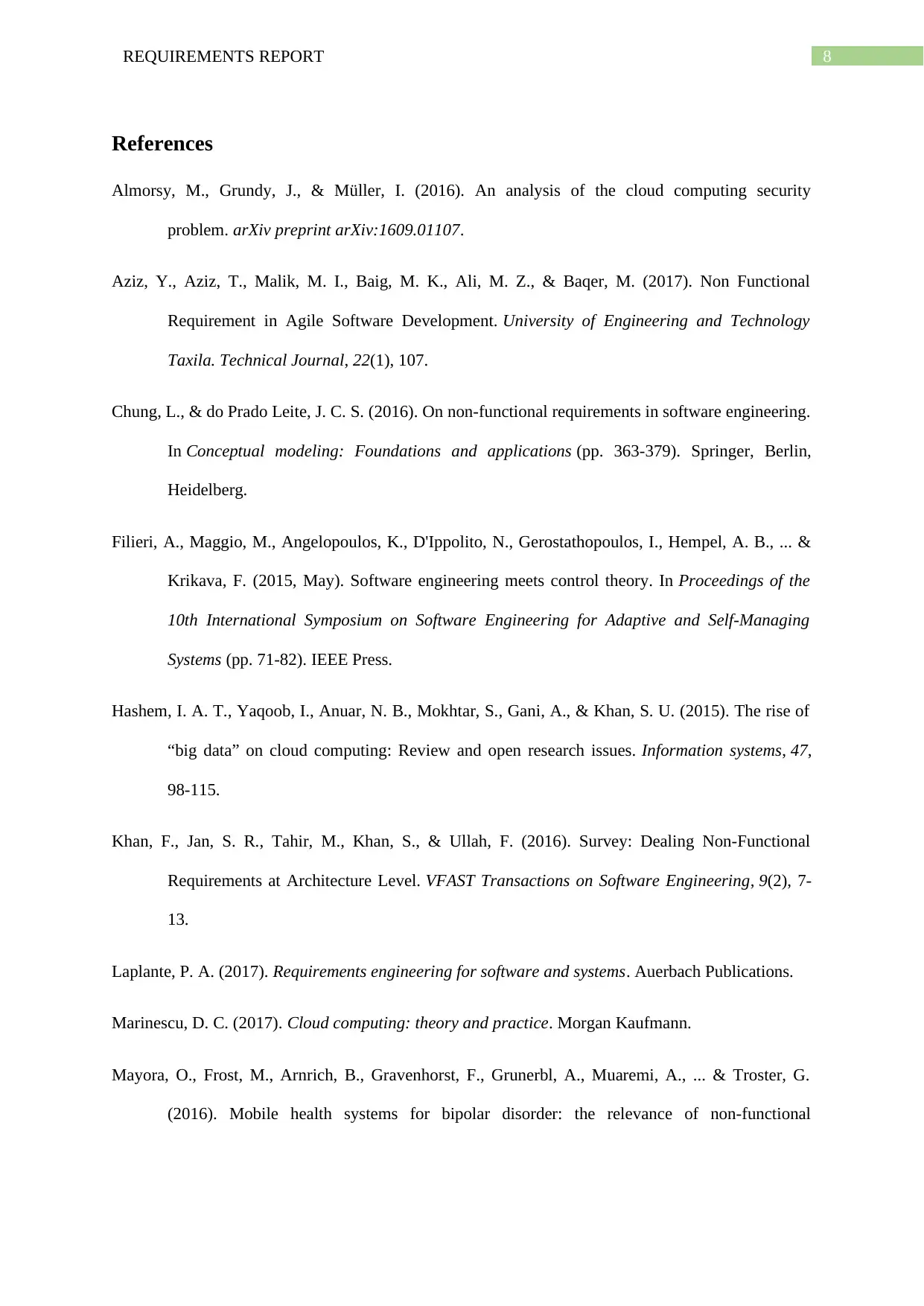
8REQUIREMENTS REPORT
References
Almorsy, M., Grundy, J., & Müller, I. (2016). An analysis of the cloud computing security
problem. arXiv preprint arXiv:1609.01107.
Aziz, Y., Aziz, T., Malik, M. I., Baig, M. K., Ali, M. Z., & Baqer, M. (2017). Non Functional
Requirement in Agile Software Development. University of Engineering and Technology
Taxila. Technical Journal, 22(1), 107.
Chung, L., & do Prado Leite, J. C. S. (2016). On non-functional requirements in software engineering.
In Conceptual modeling: Foundations and applications (pp. 363-379). Springer, Berlin,
Heidelberg.
Filieri, A., Maggio, M., Angelopoulos, K., D'Ippolito, N., Gerostathopoulos, I., Hempel, A. B., ... &
Krikava, F. (2015, May). Software engineering meets control theory. In Proceedings of the
10th International Symposium on Software Engineering for Adaptive and Self-Managing
Systems (pp. 71-82). IEEE Press.
Hashem, I. A. T., Yaqoob, I., Anuar, N. B., Mokhtar, S., Gani, A., & Khan, S. U. (2015). The rise of
“big data” on cloud computing: Review and open research issues. Information systems, 47,
98-115.
Khan, F., Jan, S. R., Tahir, M., Khan, S., & Ullah, F. (2016). Survey: Dealing Non-Functional
Requirements at Architecture Level. VFAST Transactions on Software Engineering, 9(2), 7-
13.
Laplante, P. A. (2017). Requirements engineering for software and systems. Auerbach Publications.
Marinescu, D. C. (2017). Cloud computing: theory and practice. Morgan Kaufmann.
Mayora, O., Frost, M., Arnrich, B., Gravenhorst, F., Grunerbl, A., Muaremi, A., ... & Troster, G.
(2016). Mobile health systems for bipolar disorder: the relevance of non-functional
References
Almorsy, M., Grundy, J., & Müller, I. (2016). An analysis of the cloud computing security
problem. arXiv preprint arXiv:1609.01107.
Aziz, Y., Aziz, T., Malik, M. I., Baig, M. K., Ali, M. Z., & Baqer, M. (2017). Non Functional
Requirement in Agile Software Development. University of Engineering and Technology
Taxila. Technical Journal, 22(1), 107.
Chung, L., & do Prado Leite, J. C. S. (2016). On non-functional requirements in software engineering.
In Conceptual modeling: Foundations and applications (pp. 363-379). Springer, Berlin,
Heidelberg.
Filieri, A., Maggio, M., Angelopoulos, K., D'Ippolito, N., Gerostathopoulos, I., Hempel, A. B., ... &
Krikava, F. (2015, May). Software engineering meets control theory. In Proceedings of the
10th International Symposium on Software Engineering for Adaptive and Self-Managing
Systems (pp. 71-82). IEEE Press.
Hashem, I. A. T., Yaqoob, I., Anuar, N. B., Mokhtar, S., Gani, A., & Khan, S. U. (2015). The rise of
“big data” on cloud computing: Review and open research issues. Information systems, 47,
98-115.
Khan, F., Jan, S. R., Tahir, M., Khan, S., & Ullah, F. (2016). Survey: Dealing Non-Functional
Requirements at Architecture Level. VFAST Transactions on Software Engineering, 9(2), 7-
13.
Laplante, P. A. (2017). Requirements engineering for software and systems. Auerbach Publications.
Marinescu, D. C. (2017). Cloud computing: theory and practice. Morgan Kaufmann.
Mayora, O., Frost, M., Arnrich, B., Gravenhorst, F., Grunerbl, A., Muaremi, A., ... & Troster, G.
(2016). Mobile health systems for bipolar disorder: the relevance of non-functional
⊘ This is a preview!⊘
Do you want full access?
Subscribe today to unlock all pages.

Trusted by 1+ million students worldwide
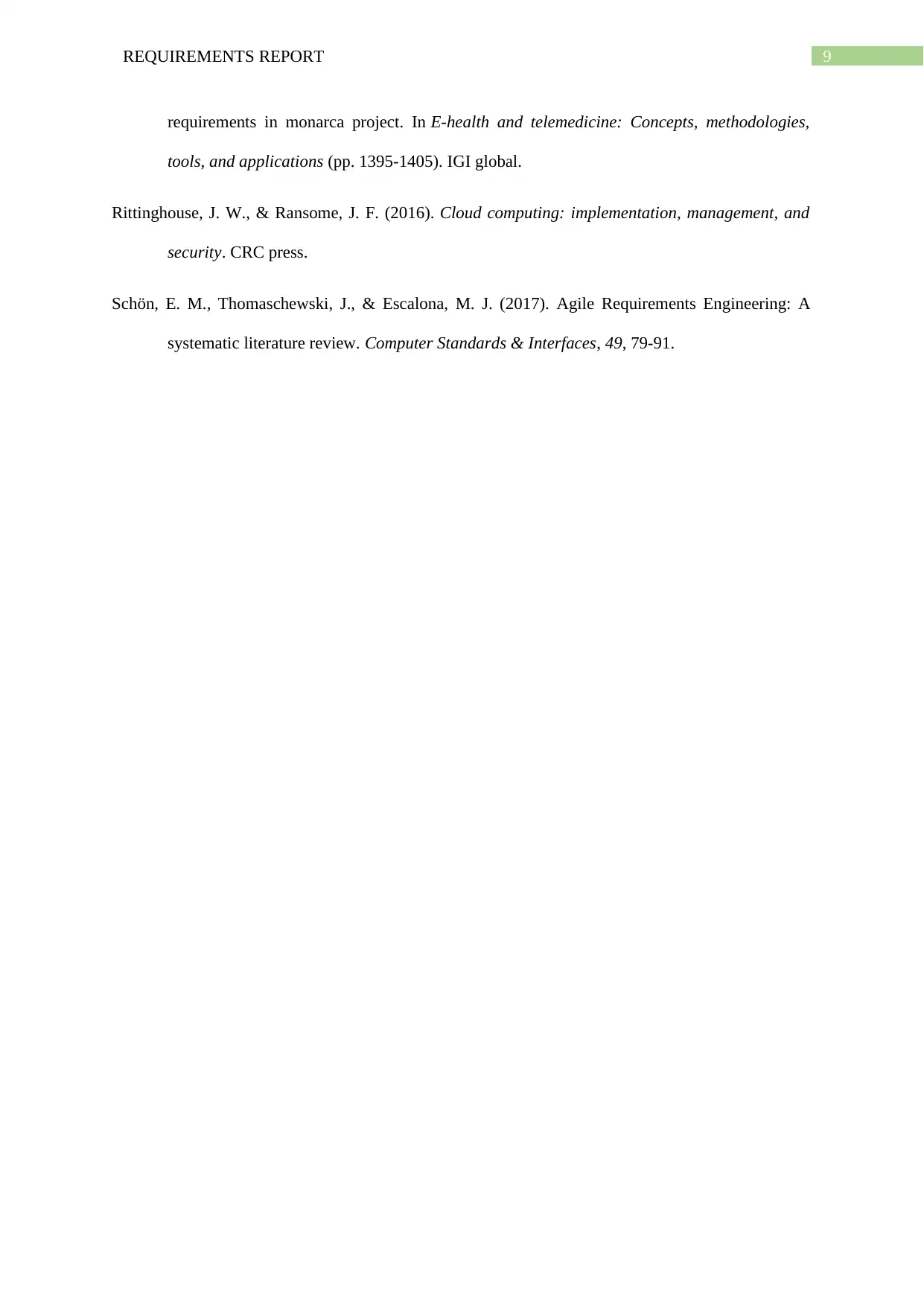
9REQUIREMENTS REPORT
requirements in monarca project. In E-health and telemedicine: Concepts, methodologies,
tools, and applications (pp. 1395-1405). IGI global.
Rittinghouse, J. W., & Ransome, J. F. (2016). Cloud computing: implementation, management, and
security. CRC press.
Schön, E. M., Thomaschewski, J., & Escalona, M. J. (2017). Agile Requirements Engineering: A
systematic literature review. Computer Standards & Interfaces, 49, 79-91.
requirements in monarca project. In E-health and telemedicine: Concepts, methodologies,
tools, and applications (pp. 1395-1405). IGI global.
Rittinghouse, J. W., & Ransome, J. F. (2016). Cloud computing: implementation, management, and
security. CRC press.
Schön, E. M., Thomaschewski, J., & Escalona, M. J. (2017). Agile Requirements Engineering: A
systematic literature review. Computer Standards & Interfaces, 49, 79-91.
1 out of 10
Related Documents
Your All-in-One AI-Powered Toolkit for Academic Success.
+13062052269
info@desklib.com
Available 24*7 on WhatsApp / Email
![[object Object]](/_next/static/media/star-bottom.7253800d.svg)
Unlock your academic potential
Copyright © 2020–2025 A2Z Services. All Rights Reserved. Developed and managed by ZUCOL.





